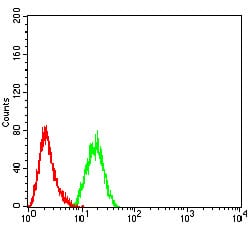


| WB | 咨询技术 | Human,Mouse,Rat |
| IF | 咨询技术 | Human,Mouse,Rat |
| IHC | 咨询技术 | Human,Mouse,Rat |
| ICC | 技术咨询 | Human,Mouse,Rat |
| FCM | 1/200 - 1/400 | Human,Mouse,Rat |
| Elisa | 1/10000 | Human,Mouse,Rat |
| Entrez GeneID | 29947 |
| clone | 2D10H11 |
| WB Predicted band size | 43.6kDa |
| Host/Isotype | Mouse IgG1 |
| Antibody Type | Primary antibody |
| Storage | Store at 4°C short term. Aliquot and store at -20°C long term. Avoid freeze/thaw cycles. |
| Species Reactivity | Human |
| Immunogen | Purified recombinant fragment of human DNMT3L (AA: 147-386) expressed in E. Coli. |
| Formulation | Purified antibody in PBS with 0.05% sodium azide |
+ +
以下是关于DNMT3L抗体的3篇参考文献及其摘要内容概括:
1. **"Dnmt3L cooperates with the Dnmt3 family of de novo DNA methyltransferases to establish maternal imprints in mice"**
- **作者**: K. Hata, M. Okano, H. Lei, E. Li
- **摘要**: 本研究利用特异性抗体证实DNMT3L与DNMT3A/DNMT3B在胚胎发育中的相互作用,揭示了DNMT3L通过辅助DNA甲基转移酶活性调控母源基因组印记的机制。
2. **"Role of the Dnmt3 family in de novo methylation and maternal imprinting"**
- **作者**: D. Bourc’his, T. H. Bestor
- **摘要**: 通过免疫沉淀和Western blot分析DNMT3L抗体,发现DNMT3L在生殖细胞中特异性表达,并参与卵母细胞甲基化模式的建立,缺失导致胚胎发育异常。
3. **"The SRA protein Np95 mediates epigenetic inheritance by recruiting Dnmt1 to methylated DNA"**
- **作者**: F. Chedin, M. R. Lieber, T. H. Bestor
- **摘要**: 研究使用DNMT3L抗体探究其与甲基化酶复合物的关联,发现DNMT3L通过识别未甲基化组蛋白标记,指导DNA甲基化在特定基因区域的沉积。
4. **"DNMT3L connects unmethylated lysine 4 of histone H3 to de novo methylation of DNA"**
- **作者**: S. K. Ooi, T. H. Bestor
- **摘要**: 通过抗体验证DNMT3L与组蛋白H3K4me0的结合能力,提出其通过识别未甲基化组蛋白标记,招募DNMT3A/B进行DNA甲基化的分子机制。
这些文献均通过DNMT3L抗体在蛋白互作、表达定位或功能研究中提供了关键实验证据,支撑了其在表观遗传调控中的核心作用。
The DNMT3L antibody is a crucial tool in epigenetic research, targeting the DNA methyltransferase 3-like (DNMT3L) protein, a regulatory cofactor in the DNMT3 family. Unlike DNMT3A and DNMT3B, DNMT3L lacks catalytic activity but plays a vital role in de novo DNA methylation by stabilizing and enhancing the enzymatic function of DNMT3A/3B, particularly during gametogenesis and early embryogenesis. DNMT3L is essential for establishing genomic imprints and silencing retrotransposons in germ cells, making it critical for normal development and fertility.
Antibodies against DNMT3L are widely used to study its expression, localization, and interaction partners in tissues such as testes, ovaries, and embryonic stem cells. They enable detection via techniques like Western blotting, immunohistochemistry, and immunofluorescence, helping researchers investigate its role in epigenetic reprogramming and cellular differentiation. DNMT3L dysregulation has been linked to imprinting disorders (e.g., Prader-Willi syndrome), infertility, and cancer, where aberrant DNA methylation patterns drive oncogenesis. These antibodies also aid in exploring DNMT3L’s non-catalytic functions in chromatin remodeling and histone modification crosstalk. Validation often involves knockout models or siRNA knockdown to confirm specificity. As epigenetic therapies gain traction, DNMT3L antibodies remain pivotal for dissecting mechanisms underlying development, disease, and potential therapeutic targets.
×